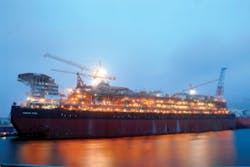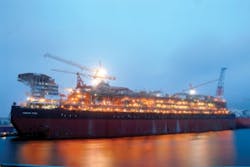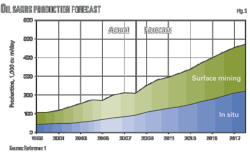Perth-based explorer Central Petroleum Ltd. has temporarily put aside teasing that resulted from its recent Ooraminna-2 gas appraisal well in the eastern Amadeus basin southeast of Alice Springs to concentrate on a rank wildcat oil prospect some 600 km to the west and close to the Northern Territory/Western Australian border.
The company's Johnstone West-1 located in Northern Territory exploration permit EPA-115 spudded in mid-August 2010 to begin a month-long evaluation of the large Johnstone West prospect, which has the potential to contain up to 500 million bbl of oil in place.
The structure, with its total areal closure of 55 sq km, was identified in the early 1980s but much better delineated and matured for drilling in seismic surveys run the past 2 years. It represents the company's best prospect for a new oil discovery in a region that is noted for being one of the most underexplored producing regions in the world.
Amadeus exploration history
The Amadeus basin contains two producing fields, Mereenie oil and gas and Palm Valley gas, both discovered in the 1960s and now nearing the end of their productive lives, along with a number of noncommercial oil and gas finds.
The Amadeus is an intracratonic, east-west trending basin 170,000 sq km in area with some 17 km thickness of sediments ranging from Devonian to Neoproterozoic in age. Its structural formation has been influenced by thick underlying evaporite formations.
As many explorers flying over the basin have remarked, the regional geology in the form of major surface anticlines and bounding faults stands up and looks at you, promising huge potential.
But the isolation from infrastructure, the tight and tough formations at depth in reservoirs of Ordovician and Cambrian age and even older, plus the low oil and gas prices of earlier decades all conspired to keep exploration to less than 40 wells throughout the basin, excluding the Mereenie and Palm Valley development wells.
Renewed search
Central, enthusiastically led by managing director John Heugh and chairman Henry Askin, both geologists with considerable experience in Australia and around the world, believes the time is ripe for a renewed exploration effort.
Initially the 2010 program focused mostly on methane and helium. It began in July with Ooraminna-2, an appraisal of a gas find considered noncommercial when made in 1963.
As Heugh pointed out, the Ooraminna structure in its entirety extends well beyond the company's mapped closure of 300 sq km to a total area of more than 1,000 sq km. The current thinking is that the structure has been formed by high level intrusion at depth of a large salt dome.
Due to the tight reservoir formation consisting of dolomitized limestone and thick calcareous shale, the hope for Ooraminna-2 centered on the intersection of naturally occurring fractures in the reservoir.
Unfortunately the well did not encounter any significant natural fractures and, because of time and financial constraints, the company was not able to suspend the well for a subsequent horizontal drilling program to try and locate them.
Despite this, Ooraminna-2 flowed under test at rates up to 152 Mcfd through a ½-in. choke following an acid squeeze.
Heugh, for one, believes Ooraminna still has enormous potential. He calls it a "sleeping monster." Ooraminna-2 was located about 1 km from the 1963 discovery well and has confirmed the presence of gas in the reservoir.
He adds that the combined CMI and sonic logs run in Ooraminna-2 had yet to be fully analyzed at this writing. These results, along with all other data from the well, will be subject to assessment by specialists for potential commercial production of the tight gas reservoir.
The evaluation will include mapping the presence and orientation of the natural fractures. This information will be used to plan for a possible focused horizontal drilling and possibly a fracturing campaign during the next attempt on the prospect.
Johnstone West prospect
Central in early September refocused its program onto oil, which offers more chance for earlier cash flow, partly because of a partner's inability to fund drilling two of its deep gas prospects.
The Johnston West prospect is 150 km northwest of Mereenie oil field and, as the basin appears to be more oil prone on the western side Central has high hopes for an oil discovery. In fact there are three major anticlinal prospects delineated in this western permit EPA-115, the other two being Surprise and Stuart.
Johnstone West, with 250 m of mapped vertical closure in the Cambro-Ordovician Pacoota sandstone reservoir and Surprise with 100 m of closure, are the two that have been advanced to drillable stage.
Central said the well began encountering oil shows in early September.
"At 1,469 m the well intersected clean white-grey, very fine-grained to coarse-grained sandstone with fair to good porosity. Up to 90% bright gold oil natural fluorescence was recorded, with visible brown oil and live oil recorded flowing with drilling mud over the rigs shale shakers while drilling and circulating drilling mud.
"The sandstones yielded a bright white-yellow instant streaming cut and solid white/yellow residual ring fluorescence. Porous sandstone was recorded over the interval 1,469-75 m, at which time drilling ceased in order to cut an 18 m core. Gas was recorded at 3 units of methane with minor quantities of heavier ethane, propane and butane. There was no evidence that the oil show did not continue further."
The core will aid Central in determining potential reservoir vertical extent and quality as well as stratigraphic determination.
This new zone of interpreted Ordovician Larapinta Group underlies a mainly siltstone interval in the gross interval 1,409-69 m overlain by the significant shows in the interval 1,387-1,409 m described a day earlier.
"The siltstone interval was comprised of mainly medium to dark grey siltstone with occasional thin interbeds of very fine-grained sandstone and light grey dolomite in the upper part. The sandstones recorded in part weak fluorescence and crush cut. Oil shows ranging from poor to excellent have now been recorded with no evidence of a water leg from 1,387 m to 1,475 m, 88 m thus far.
"The stratigraphy of these Ordovician sandstones depends on the age of the top seal (1,315-67 m) which has affinities with both the Stokes siltstone and to a lesser degree with the Horn Valley siltstone. Depending on the age of the seal, the underlying sandstones could be either Stairway sandstone or Pacoota sandstone, respectively.
"Final interpretation of this hydrocarbon show and others which may be encountered is dependent on further assessments via logging/coring and testing but these initial indications demonstrate the presence of an active oil kitchen in the adjacent Johnstone Trough. This boosts the exploration potential of this general area, the chances of finding further oil in JW-1 and the probability of a positive decision to the drilling of Surprise-1," Central said.
A significant oil discovery would provide a clear path to commercialization as production could be trucked to Alice Springs. From there it could be trucked to the Port Bonython facility at the Spencer Gulf terminal in South Australia for sale at that point. Alternatively the oil could be sent by rail from Alice Springs north to Port Darwin.
Central has estimated operating costs for oil production and sales from central Australia (including trucking, exploration and development) to be (Aus.) $25-35/bbl.
Large volume oil production economics could benefit by transport to Port Darwin in bulk liquid tankers on the recently established rail route which, according to national freight rate averages, should cost less than $5/bbl for the rail freight component of total production costs.
Although there is still some doubt about a four directional closure for the structure due to possible seismic velocity gradients, Surprise has the added attraction of being a shale gas/oil prospect as well as an oil target.
Central was preparing the Surprise-1 pad in early September 8 km south of Johnstone West in case Johnstone West-1 found oil. The company believes the Ordovician Horn Valley siltstone and various shales and tight gas-oil sands in the Ordovician Stairway sandstone may represent unconventional objectives at both Johnstone West and Surprise in addition to the conventional targets.
Other exploratory prospects
Central also has its eyes on Magee and Mount Kitty, two large gas prospects on the eastern side of the basin, neither of which is to be drilled in 2010 with the company's redirection toward oil.
Apart from conventional methane targets, both prospects have the added potential to contain high levels of helium.
Magee, located in permit EP 82, was first drilled with Magee-1 in 1992. That well penetrated a significant salt seal into the Precambrian Heavitree quartzite reservoir and flowed gas to surface, which had 6.3% helium content as well as methane and condensate. At this location the well encountered 6 m of Heavitree formation.
Recent work on Magee suggests the structure contains as much as 800 bcf of methane and 15 bcf of helium in place.
Central's proposal for Magee-2 is to locate the well farther east such that it drills through the prominent Magee thrust fault and targets a thicker (up to 200 m) section of Heavitree reservoir beneath the fault, thus increasing exposure to the potential methane and helium resource. Another target is in Lower Cambrian Arumbera sandstones.
The Mount Kitty structure, located in permit EP-125 about 130 km southwest of Magee, has been delineated for some time but never drilled.
It is very large, with about 430 sq km of areal closure and the capacity to hold up to 1.7 tcf of recoverable gas and 105 bcf of helium.
Central also retained consultants to conduct in-depth studies of shale gas, shale oil, tight gas sands, and tight oil sands potential on its Amadeus and Georgina basin holdings.
More Oil & Gas Journal Current Issue Articles
More Oil & Gas Journal Archives Issue Articles
View Oil and Gas Articles on PennEnergy.com




